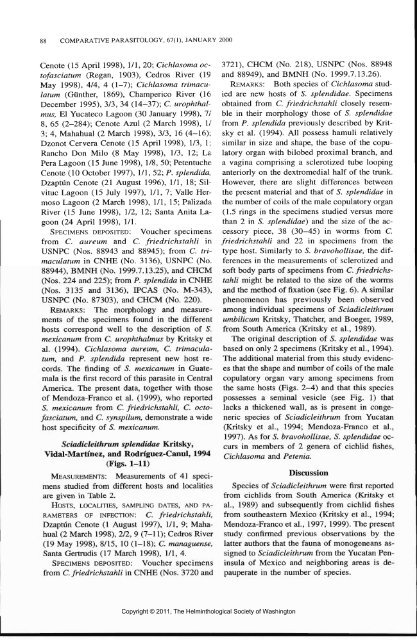Comparative Parasitology 67(1) 2000 - Peru State College
Comparative Parasitology 67(1) 2000 - Peru State College
Comparative Parasitology 67(1) 2000 - Peru State College
Create successful ePaper yourself
Turn your PDF publications into a flip-book with our unique Google optimized e-Paper software.
COMPARATIVE PARASITOLOGY, <strong>67</strong>(1), JANUARY <strong>2000</strong><br />
Cenote (15 April 1998), 1/1, 20; Cichlasoma octofasciatum<br />
(Regan, 1903), Cedros River (19<br />
May 1998), 4/4, 4 (1-7); Cichlasoma trimaculatum<br />
(Giinther, 1869), Champerico River (16<br />
December 1995), 3/3, 34 (14-37); C. urophthalmus,<br />
El Yucateco Lagoon (30 January 1998), 7/<br />
8, 65 (2-284); Cenote Azul (2 March 1998), I/<br />
3; 4, Mahahual (2 March 1998), 3/3, 16 (4-16);<br />
Dzonot Cervera Cenote (15 April 1998), 1/3, 1;<br />
Rancho Don Milo (8 May 1998), 1/3, 12; La<br />
Pera Lagoon (15 June 1998), 1/8, 50; Petentuche<br />
Cenote (10 October 1997), 1/1, 52; P. splendida,<br />
Dzaptun Cenote (21 August 1996), 1/1, 18; Silvituc<br />
Lagoon (15 July 1997), 1/1, 7; Valle Hermoso<br />
Lagoon (2 March 1998), 1/1, 15; Palizada<br />
River (15 June 1998), 1/2, 12; Santa Anita Lagoon<br />
(24 April 1998), 1/1.<br />
SPECIMENS DEPOSITED: Voucher specimens<br />
from C. aureum and C. friedrichstahli in<br />
USNPC (Nos. 88943 and 88945); from C. tri<br />
maculatum in CNHE (No. 3136), USNPC (No.<br />
88944), BMNH (No. 1999.7.13.25), and CHCM<br />
(Nos. 224 and 225); from P. splendida in CNHE<br />
(Nos. 3135 and 3136), IPCAS (No. M-343),<br />
USNPC (No. 87303), and CHCM (No. 220).<br />
REMARKS: The morphology and measurements<br />
of the specimens found in the different<br />
hosts correspond well to the description of S.<br />
mexicanum from C. urophthalmus by Kritsky et<br />
al. (1994). Cichlasoma aureum, C. trimaculatum,<br />
and P. splendida represent new host records.<br />
The finding of S. mexicanum in Guatemala<br />
is the first record of this parasite in Central<br />
America. The present data, together with those<br />
of Mendoza-Franco et al. (1999), who reported<br />
S. mexicanum from C. friedrichstahli, C. octofasciatum,<br />
and C. synspilum, demonstrate a wide<br />
host specificity of 5. mexicanum.<br />
Sciadicleithrum splendidae Kritsky,<br />
Vidal-Martmez, and Rodriguez-Canul, 1994<br />
(Figs. 1-11)<br />
MEASUREMENTS: Measurements of 41 specimens<br />
studied from different hosts and localities<br />
are given in Table 2.<br />
HOSTS, LOCALITIES, SAMPLING DATES, AND PA-<br />
RAMETERS OF INFECTION: C. friedrichstahli,<br />
Dzaptun Cenote (1 August 1997), 1/1, 9; Mahahual<br />
(2 March 1998), 2/2, 9 (7-11); Cedros River<br />
(19 May 1998), 8/15, 10 (1-18); C. managuense,<br />
Santa Gertrudis (17 March 1998), 1/1, 4.<br />
SPECIMENS DEPOSITED: Voucher specimens<br />
from C. friedrichstahli in CNHE (Nos. 3720 and<br />
Copyright © 2011, The Helminthological Society of Washington<br />
3721), CHCM (No. 218), USNPC (Nos. 88948<br />
and 88949), and BMNH (No. 1999.7.13.26).<br />
REMARKS: Both species of Cichlasoma studied<br />
are new hosts of S. splendidae. Specimens<br />
obtained from C. friedrichstahli closely resemble<br />
in their morphology those of S. splendidae<br />
from P. splendida previously described by Kritsky<br />
et al. (1994). All possess hamuli relatively<br />
similar in size and shape, the base of the copulatory<br />
organ with bilobed proximal branch, and<br />
a vagina comprising a sclerotized tube looping<br />
anteriorly on the dextromedial half of the trunk.<br />
However, there are slight differences between<br />
the present material and that of S. splendidae in<br />
the number of coils of the male copulatory organ<br />
(1.5 rings in the specimens studied versus more<br />
than 2 in S. splendidae) and the size of the accessory<br />
piece, 38 (30—45) in worms from C.<br />
friedrichstahli and 22 in specimens from the<br />
type host. Similarly to S. bravohollisae, the differences<br />
in the measurements of sclerotized and<br />
soft body parts of specimens from C. friedrichstahli<br />
might be related to the size of the worms<br />
and the method of fixation (see Fig. 6). A similar<br />
phenomenon has previously been observed<br />
among individual specimens of Sciadicleithrum<br />
umbilicum Kritsky, Thatcher, and Boeger, 1989,<br />
from South America (Kritsky et al., 1989).<br />
The original description of S. splendidae was<br />
based on only 2 specimens (Kritsky et al., 1994).<br />
The additional material from this study evidences<br />
that the shape and number of coils of the male<br />
copulatory organ vary among specimens from<br />
the same hosts (Figs. 2-4) and that this species<br />
possesses a seminal vesicle (see Fig. 1) that<br />
lacks a thickened wall, as is present in congeneric<br />
species of Sciadicleithrum from Yucatan<br />
(Kritsky et al., 1994; Mendoza-Franco et al.,<br />
1997). As for S. bravohollisae, S. splendidae occurs<br />
in members of 2 genera of cichlid fishes,<br />
Cichlasoma and Petenia.<br />
Discussion<br />
Species of Sciadicleithrum were first reported<br />
from cichlids from South America (Kritsky et<br />
al., 1989) and subsequently from cichlid fishes<br />
from southeastern Mexico (Kritsky et al., 1994;<br />
Mendoza-Franco et al., 1997, 1999). The present<br />
study confirmed previous observations by the<br />
latter authors that the fauna of monogeneans assigned<br />
to Sciadicleithrum from the Yucatan Peninsula<br />
of Mexico and neighboring areas is depauperate<br />
in the number of species.
















